Evolution Of The Flight Attendant Uniform
We have come a long way since the early days of aviation. From the bumpy rides of early 1900s airliners to the glamorous, smoke-filled flights of the 1960s, air travel has changed a lot.
When lying was a special experience, passengers dressed their Sunday best. Flight attendants matched this elegance with tailored suits or dresses, often complemented by stylish hats. This formal and glamorous atmosphere defined air travel during that era.
Time passes by, and something changes. Flight attendants are seen as modern, professional, and enthusiastic workers. Their uniforms mirror the era’s fashion, evolving with the times.
They have improved to ensure cabin crew can perform their duties efficiently while presenting a polished image. Let’s explore some of the most memorable flight attendant styles throughout history.
1930s-1940s: The Early Years

The main role of cabin crew members has always been to keep passengers safe. Their uniforms have changed over the years to help them do their task better.
In the late 1920s and early 1930s, cabin crew uniforms were heavy and had a military look. They wore large caps, capes, and skirts that covered their knees to show professionalism, but capes weren’t very practical.
Frances, a fashion historian and stylist, said: “Their uniforms were extremely structured, resembling military attire. Greens and grays were used to create wool skirt suits, capes, and hats.”

During World War II, there was less fabric available, so uniforms became simpler and more fitted. Capes were gone, and the new style included blazers, skirts, hats, and small heels in muted colors.
This look matched the well-dressed passengers and gave off a respectable air. Women wore heels but could switch to flats in the air. They also wore girdles under their skirts to look smooth and neat.

Pan American, inspired by luxurious ocean liners, called its pilots “captains” and dressed crews in naval-style uniforms.
These featured white hats and navy-blue, double-breasted jackets with rank insignia on the sleeves. Other airlines adopted similar customs, many of which persist today.

The first stewardess uniform was dark green wool with a matching green and gray cape. United Air Lines created a replica of this uniform to honor Ellen Church, the first stewardess and United’s “Original Eight” female flight attendants.

One of the earliest flight attendants on a European flight worked for Swissair. Their uniforms featured traditional silhouettes in plain colors, often complemented by accessories like hats and pantyhose.
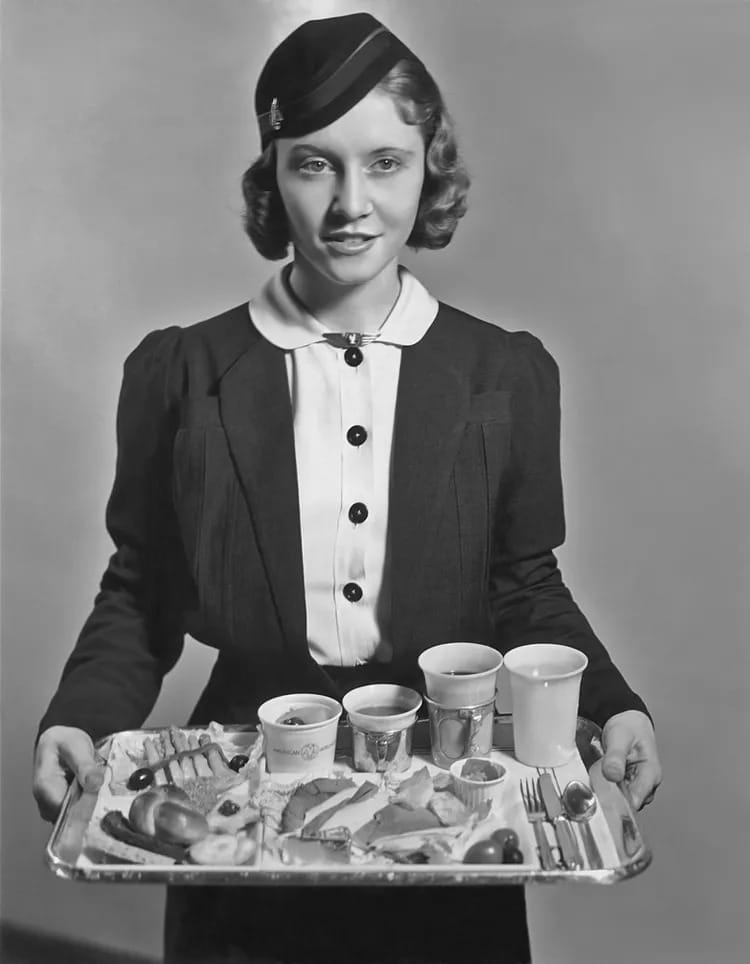







1950s-1960s: The Glamorous Era

After World War II, airlines focused on making air travel glamorous and elegant. Uniforms became more stylish and feminine.
During this time, air travel became more accessible to the middle class. Flight attendants wore classic suits with tea-length skirts, white gloves, and pillbox hats to match well-dressed passengers.

Famous designers like Christian Dior and Oleg Cassini created their uniforms. The term “stewardess” became a marketing tool, portraying these women as stylish, knowledgeable, and glamorous.
They had to be young, single, childless, within certain height and weight limits, hold a college degree, pass a personality test, and follow strict grooming rules.

In 1959, Qantas flight attendants wore belted short-sleeved midi dresses featuring three buttons in the front and shawl lapels. The outfit was completed with a matching pillbox-like hat, dark-colored heels, and gloves.

In the late 1950s, Delta flight attendants wore fitted navy-blue blazers with large round buttons, over-collared white shirts paired with navy-blue skirts, heels, and pillbox hats. According to Delta, this specific uniform was used by flight attendants during the winter from 1957 to 1959.
The airline industry changed under Title VII of the 1964 Civil Rights Act. Lawsuits in the late 1960s brought more protections for women, challenging height and weight requirements. Uniforms started reflecting a broader range of ages and sizes and included male flight attendants.
By 1963, American Airlines stewardesses also protested mandatory retirement at age 32, marking the beginning of significant changes in the industry.
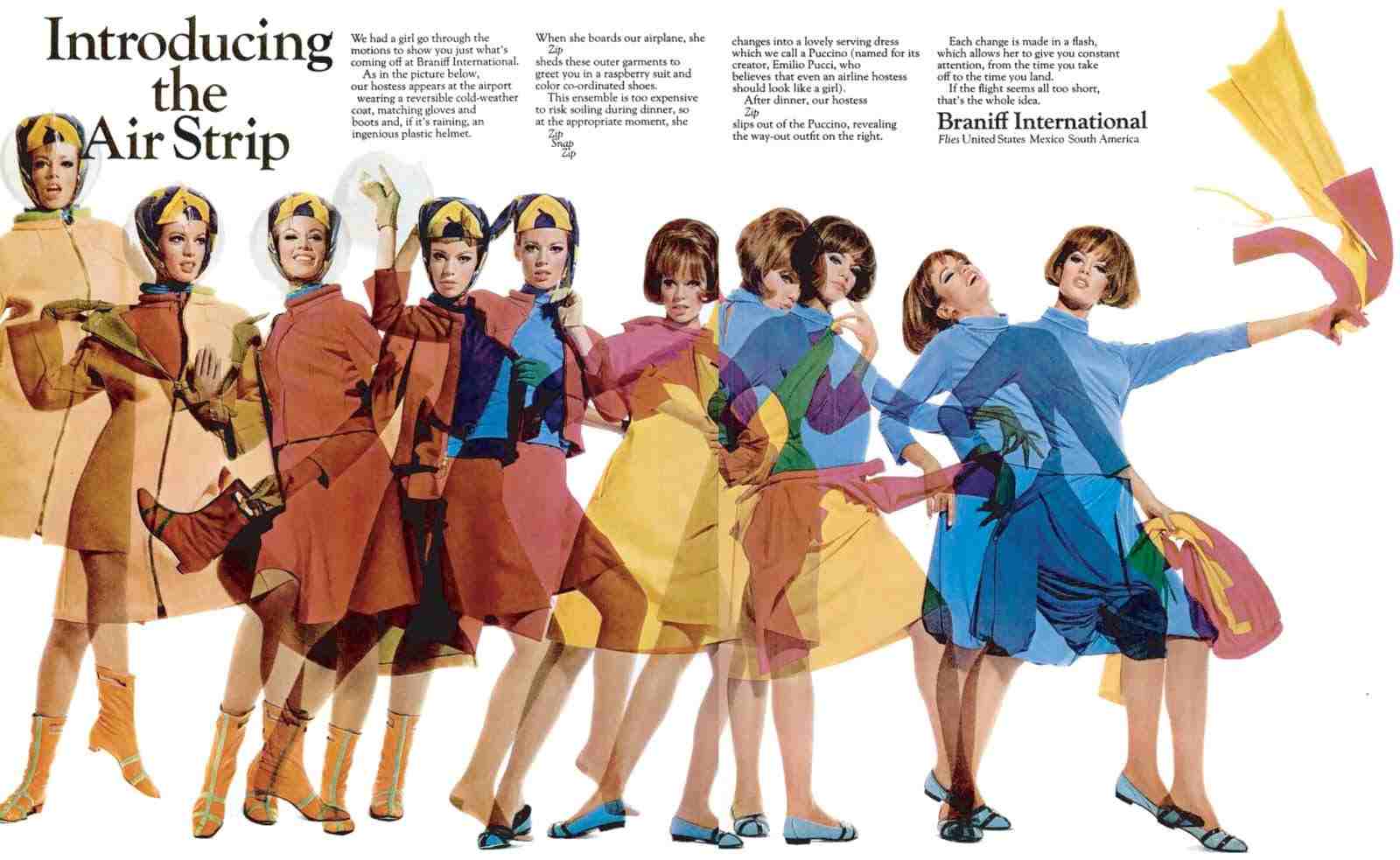
In 1965, Braniff International Airways hired Emilio Pucci to design new uniforms. Pucci’s “Air Strip” design featured layers to be removed during the flight, including multi-colored smocks, space helmets, and tall boots.

In the mid-60s, Trans World Airlines introduced new uniforms designed by couturier Pierre Balmain, which were simple, crisp, and French-inspired.

A trio of American Airlines flight attendants posed on an airport tarmac in the new tri-colored uniforms, which caught the public’s eye through a wide-reaching national campaign. The uniforms featured red, white, and blue sheath dresses accessorized with matching belts and hairbows.

The uniforms for Air France were designed by Cristóbal Balenciaga in 1969. Balenciaga created these designs at his fashion house in Paris, and they were among his final works before he passed away in 1972.
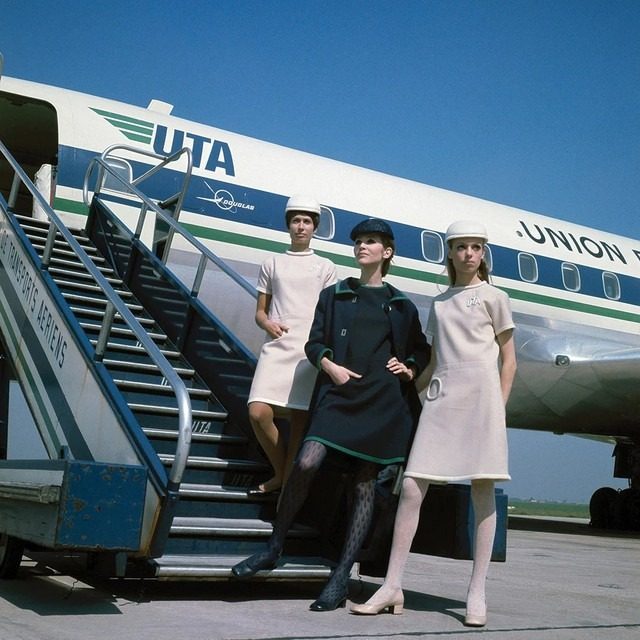
In 1968, Pierre Cardin was tasked with designing the uniforms for UTA Airlines. The French-Italian designer infused his creations with influences from his own “Cosmos” collection.
The summer uniforms were made from beige gabardine fabric with white trim, while the winter uniforms featured blue jersey with green trim. Both designs included matching hats that coordinated with the outfits.

The uniforms for United Airlines, designed by Jean Louis in 1968, included dresses for 4,500 flight attendants. These designs were used as uniforms between 1968 and 1970.

In 1968, Southwest Airlines introduced flight hostesses in go-go boots and belted miniskirts, branding themselves as the “love airline.” They served “love bites” and “love potions” to attract businessmen to cheaper flights with better service. The image shifted from housewife-to-be to playful sky hostesses.
1970s: Casual and Functional
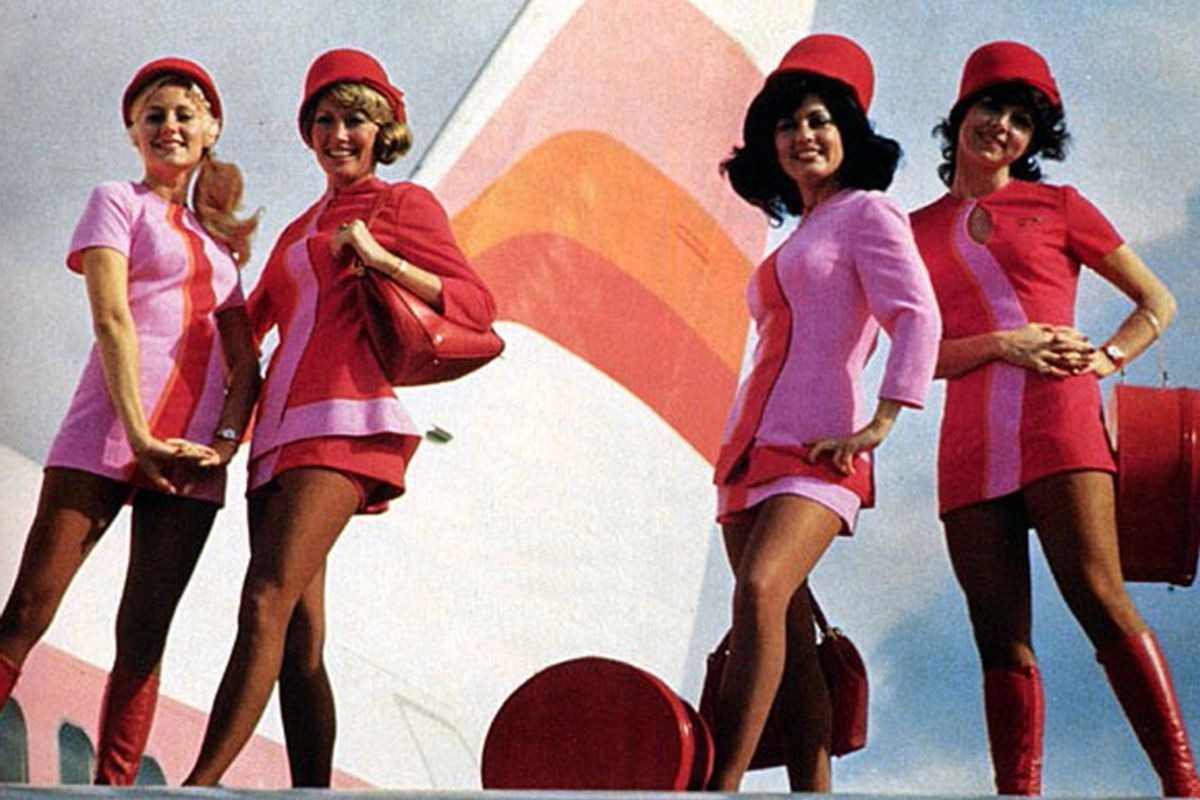
The 1970s saw the arrival of bright colors, psychedelic patterns, short skirts, and go-go boots in airline uniforms.
The term “stewardess” evolved into the gender-neutral “flight attendant.” New laws prohibiting discrimination based on age, appearance, and gender led to the return of men to the profession.
Following the federal deregulation of commercial aviation, airlines competed by offering low fares, frequent service, and more routes.
As a result, they no longer felt the need to hire only attractive young women. Business-style uniforms returned, emphasizing professionalism and functionality. They were stylish yet practical, enhancing employee productivity.

At the beginning of the 70s, Southwest Airlines debuted bright uniforms for their flight attendants, featuring tall white go-go boots and matching white belts that added flair to the short hemlines.

Renowned designers like Valentino and Yves Saint Laurent. They brought modern and stylish looks while maintaining comfort and functionality for flight attendant uniforms.
In 1971, Valentino infused his passion for color into the uniform design for Trans World Airlines. The introduction of this uniform also marked a significant shift in airline fashion, as age restrictions were abolished.

Also in 1971, Emilio Pucci named his next collection for Braniff International Airways, “747 Braniff Place,” to honor the airline’s new jet. His famous patterned designs appeared as decorative trims on the skirts, creating a refined and sophisticated look for the flight attendants.

In 1973, André Courrèges designed new uniforms for the UTA flight crew. His collection for the airline included skirts, straight-leg trousers, fitted sweaters, and short jackets made from faux leather.

For most of the ’70s, cabin crew members wore dark blue minidresses designed by Hanae Mori. The uniform featured a glossy red belt and dark blue shoes, both adorned with large red discs reminiscent of Japan’s flag.
Flight attendants accessorized this ensemble with white gloves, black tights, a blue and red scarf, and a wide, rounded hat.

In this period, airlines embraced bold colors and patterns. Pan Am introduced its first above-the-knee hemline and bold color choices of Superjet Blue and Galaxy Gold.

The first Delta flight attendant uniform to include pants featured navy blue bell bottoms, and hats were no longer required.
The uniform also included pleated mini-skirts and tunics made of wrinkle-free polyester in orange, navy blue, and white, coordinating with the interior of Delta’s new Boeing 747. The serving smock was bright yellow.
Accessories included a navy blue ribbon beret, patent leather pumps or heeled loafers with gold hardware, optional boots, a “tomato red” topcoat, a yellow raincoat, and a yellow duffel bag purse with a red, white, and blue striped shoulder strap.
This uniform was designed by Sharon Harris for the Fashionaire Division of Hart Schaffner & Marx.

Southwest Airlines embraced the flamboyant 1970s with striped pant ensembles that were popular with domestic flyers.
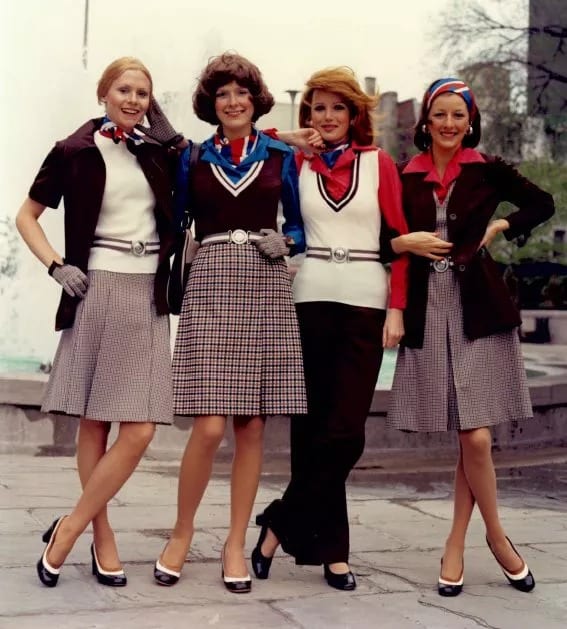
Air Canada opted for a red, white, and blue scheme but made a statement with a variety of uniform options. This approach to providing a collection of distinct uniforms has now become the norm for most airlines.

In 1976, Nina Ricci designed uniforms for Air New Zealand featuring blue, green, and white colors with geometric patterns.

In the 1970s, British Airways flight attendants wore pinstriped sets paired with white shirts and double-breasted overcoats. Models Myrtle Winston, Diane Edmunds, Sonia Pugin, and Chris Harris showcased these British Airways uniforms on the streets of London in 1977.

In 1979, bidding farewell to the bold and avant-garde styles, UTA collaborated with the luxury French fashion house Hermès to introduce new uniforms with a classic romantic design.
1980s: Professional and Polished
By the 1980s, following deregulation and progress in gender equality, flight attendant uniforms adopted a more conservative, business-like appearance.
Uniforms became more structured and professional attire, with airlines opting for tailored suits and modest dresses. The focus was on presenting a polished and professional image in line with the corporate culture of the decade.
Some uniforms at this time featured oversized ties and shoulder pads, blending style with functionality. As air travel became busier, the focus shifted to providing efficient service.

Delta introduced its first uniform with maternity wear during this decade. The flight attendant image shifted from a glamorous “Playboy Bunny” look to that of a safety professional, with androgynous pantsuits and blouses becoming common.


After the vibrant 1970s, Qantas returned to a more classic color palette, featuring loose-fitting looks with touches of its signature red.

Yves Saint Laurent designed the uniforms for Qantas Airways in 1986. The jacket style, with its tuxedo-inspired cut and shoulder pads, was based on his power suit designs from the 1980s.
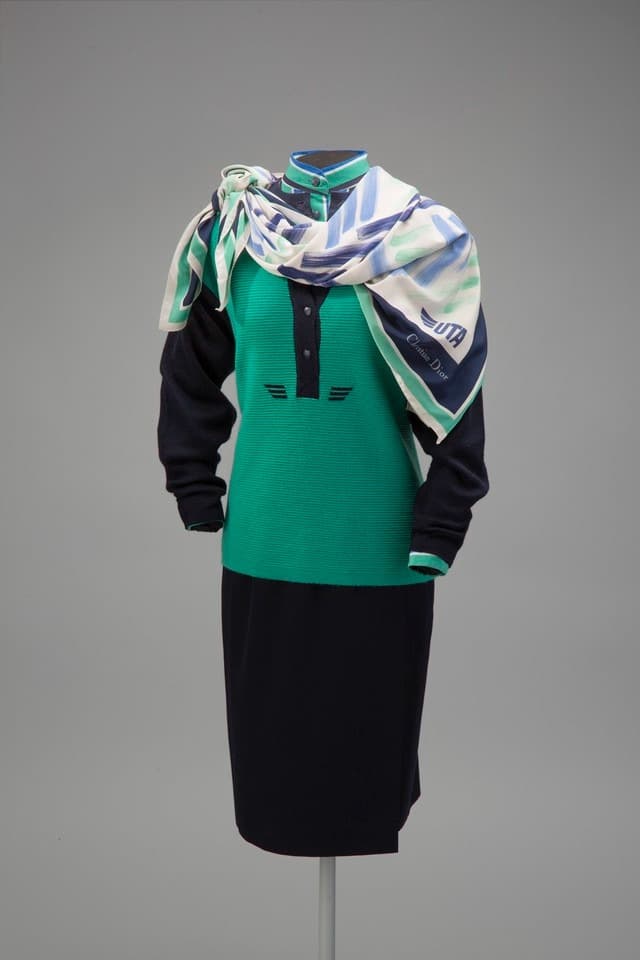
In 1987, UTA once again updated its uniforms. Marc Bohan, the creative director of Christian Dior at the time, was responsible for the designs, which reflected the “power dressing” trend for women in the 1980s.
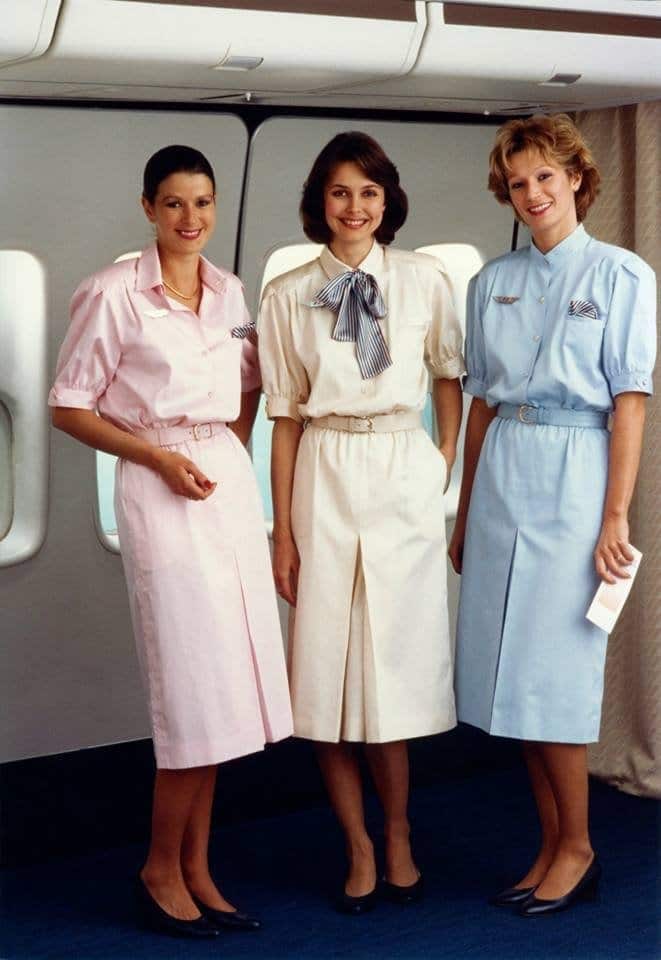
In the late 80s, Air France flight attendants adopted pastel summer dresses designed by Louis Féraud, featuring shoulder pads and optional large loose bows.
1990s-2000s: Brand Identity

During the 1990s and 2000s, airlines focused on brand identity through their uniforms. Renowned fashion designers were often commissioned to create custom looks that embodied the airline’s ethos.
British Airways and Singapore Airlines, for example, opted for bespoke designs that were both stylish and functional, with an emphasis on comfort for long flights.

In the early 1990s, United became the first airline to issue an official maternity uniform for its female pilots. By this time, the industry and the public had accepted that all qualified individuals, regardless of race or gender, could work aboard an airliner.
Some uniforms reflected national traditions. Emirates, based in Dubai, features a Western-style uniform with a distinctive hat and veil.

Indian airlines often issue saris for their female flight attendants, while Thai Airlines’ female attendants wear Thai silk uniforms with an orchid on their lapel. Singapore and Malaysian airlines incorporate traditional sarong kebayas, a blouse-dress combination, into their uniforms.
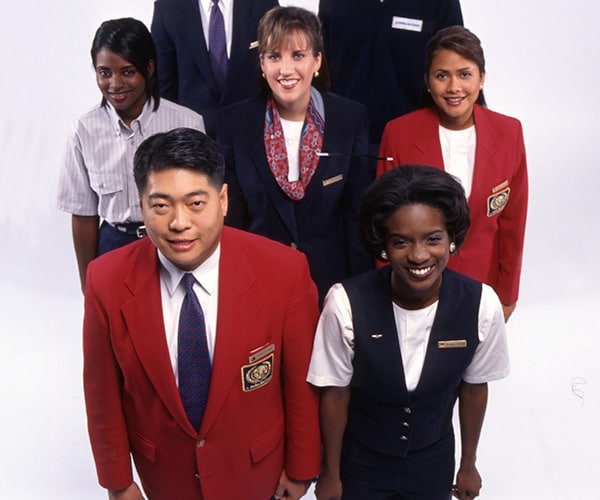
The nineties Delta introduced a vibrant burst of color to the 80s styles, featuring a combination of red and blue jackets for both men and women. Some blazers also included gold embroidered patches.
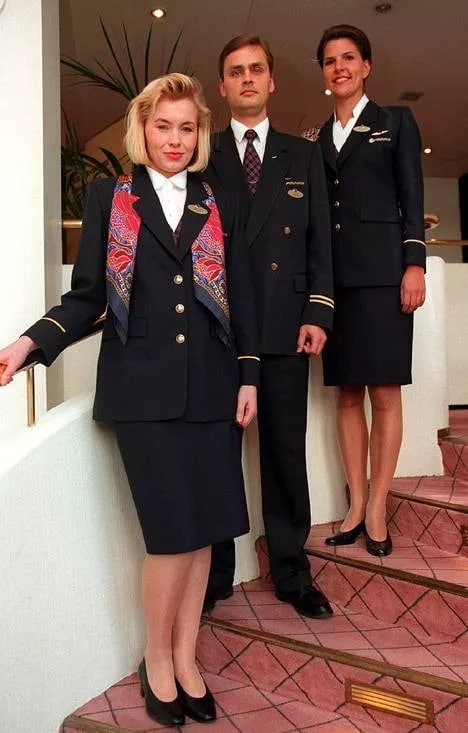
Finland Air revisited conservative suits with only small touches of color, such as silk scarves. Traditional skirt suits were accessorized with low heels.

In 1993, Irish designer Paul Costello gave British Airways a new look. His version of the uniform featured patterned blouses and bowler hats adorned with red and blue ribbons.
2010s-Present: Modern and Inclusive
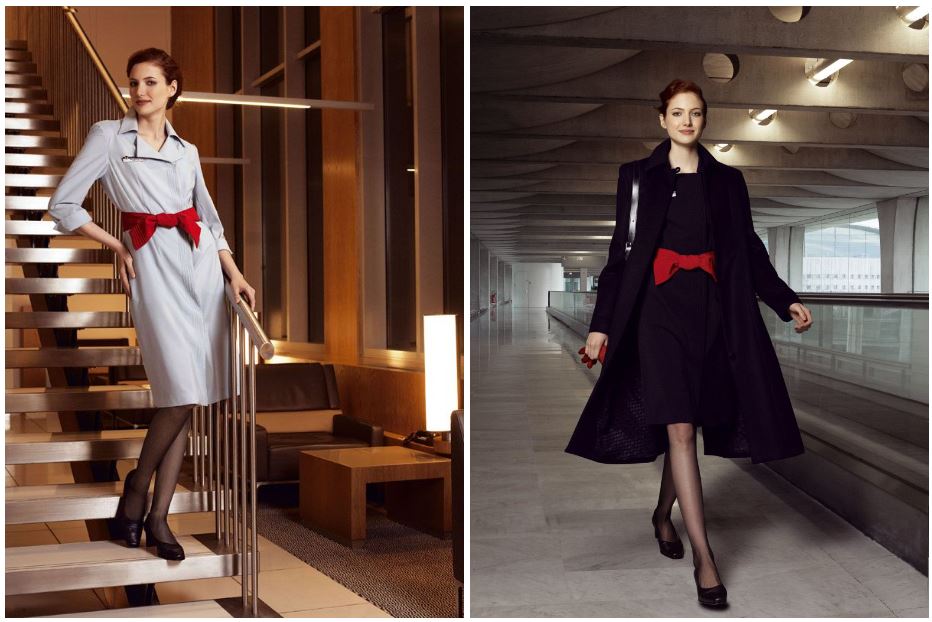
By the 2000s, flight attendant uniforms became simpler and more streamlined, prioritizing comfort over flair.
In 2005, Christian Lacroix created a rich collection of 100 fashion items for Air France. These designs could be mixed and matched, giving the flight crew the opportunity to showcase their unique personal styles.

The uniforms for Aeroméxico, designed by Macario Jiménez in 2008, featured polyester woven fabric suits that were officially worn from 2008 to 2011.
In 2012, Virgin America partnered with Banana Republic to bring back the style of the “golden age of travel,” creating a fashion-forward crew. In 2016, Cole Haan and Zac Posen designed stylish and functional uniforms for American Airlines and Delta, looking toward the future.

Inspired by the Qantas logo, designer Martin Grant developed a modern range of uniforms in a palette of Qantas red, ruby red, and fuchsia. The look is finished with simple belts and scarves.
Recently, flight attendant uniforms have evolved to reflect cultural shifts and the need for inclusivity. Most major airlines still have separate designs for men and women, but there’s a growing push for gender-neutral clothing that aligns with each flight attendant’s identity.

Some airlines, like Virgin Atlantic and United, have introduced gender-fluid options. Virgin added trousers and flats for women and neckties for either gender.
United debuted gender-neutral pieces like tunics and pants that anyone can mix and match. Demi M., a flight attendant with TUI Fly, noted that her company now allows men to wear dresses and skirts.

Uniform styles have also trended towards casual and functional, using breathable, flexible fabrics for comfort and relaxing makeup policies.
Budget carrier PLAY Airlines now offers gender-neutral uniform options, including mix-and-match pants, T-shirts, sweatshirts, blazers, and sneakers in their signature red. PLAY has also removed rules regarding hair, makeup, tattoos, and nail polish.
PLAY’s CEO, Birgir Jónsson, highlighted that their friendly, attentive crew, dressed in iconic red, makes passengers feel comfortable. With all they do for their passengers, flight attendants deserve to be comfortable too.







